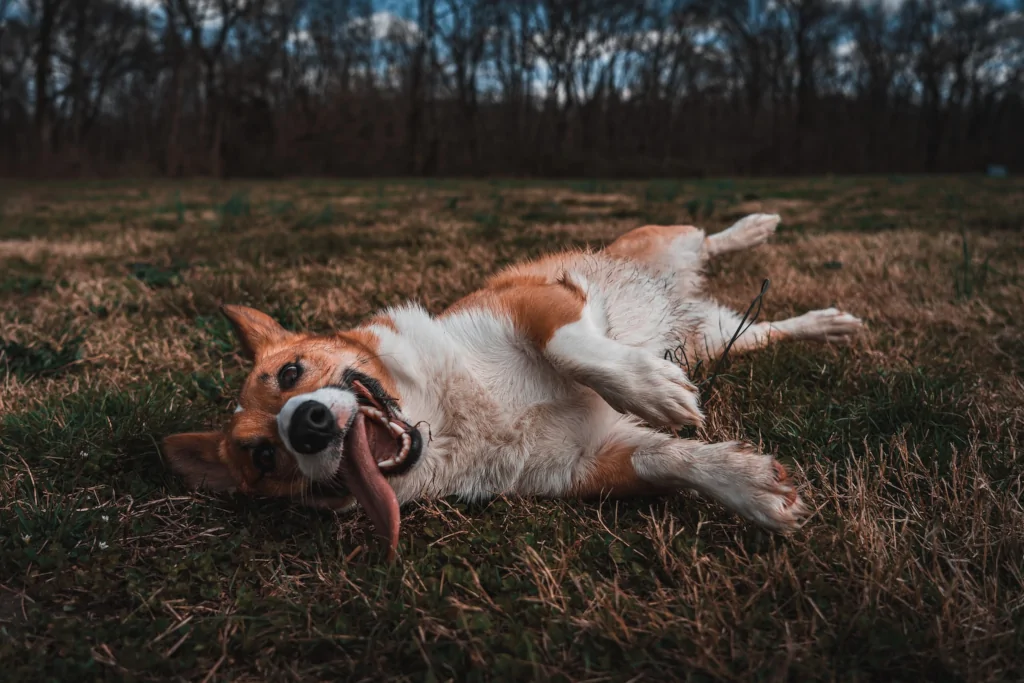Are you tired of the same old sit and stay commands? Looking to impress your friends and family with a fun and unique trick for your beloved canine companion? You’re in the right place!
Get ready to unleash your dog’s inner actor with the “Play Dead” command, a trick that will not only entertain but also strengthen the bond between you and your four-legged friend.
Trust us, this is one command that’s sure to bring smiles and laughter to everyone around.

Why “Play Dead” Is a Great Trick to Teach
Teaching your dog to “Play Dead” is more than just a fun party trick – it’s a wonderful way to mentally stimulate your pet and reinforce obedience training.
This engaging command challenges your dog’s focus and concentration, making it an excellent addition to your training repertoire.
Plus, you’ll both enjoy the delightful reactions from your audience as your dog dramatically drops to the ground and rolls over on command!
Preparing for the Training Session: What Do You Need?
Before diving into the world of canine theatrics, let’s make sure you’ve got everything you need to set the stage for success. For a smooth training experience, you’ll need:
- A quiet, distraction-free environment. Choose a comfortable space where your dog can focus on learning without being interrupted by noise or other animals.
- Tasty treats. High-value, bite-sized treats will help to keep your dog motivated and eager to learn. The more enticing the treat, the more likely your dog is to perform the trick.
- A clicker (optional). A clicker can be a useful tool for marking the precise moment your dog performs the desired action, helping them understand what’s being rewarded.
- Patience and positivity. Remember, training should be a fun and rewarding experience for both you and your dog, so keep the atmosphere upbeat and encouraging.
Now that you’re prepared, it’s time to let the play begin! Get ready for your dog’s acting debut and watch as they master the “Play Dead” command in no time.
Step-By-Step: How to Teach the Play Dead Trick
Step 1: Start with the Down Position
Before teaching the “Play Dead” command, your dog should be comfortable with the “Down” position.
If your dog isn’t familiar with this command, begin by teaching them to lie down on their side, either by luring them with a treat or gently guiding them into position. We have an easy-to-follow guide for the “Down” command for you. Check it out!
Step 2: Introduce a Verbal Cue or Hand Signal
Choose a verbal cue (such as “Bang!” or “Play Dead!”) or a hand signal that you’ll use consistently to signal the trick. Start by saying the cue or showing the hand signal while your dog is in the “Down” position.
Step 3: Lure Your Dog Into the ‘Dead’ Position
Hold a treat close to your dog’s nose, then slowly move it away, encouraging your dog to roll onto their back or side.
As your dog follows the treat, gently guide them into the desired “dead” position, where they are lying on their side or back with their legs outstretched.
Step 4: Reward and Praise
As soon as your dog achieves the “dead” position, immediately reward them with a treat and praise. If you’re using a clicker, click at the exact moment your dog reaches the position, followed by a treat.
Step 5: Practice and Gradually Remove the Lure
Continue practicing the trick, gradually reducing your reliance on the treat as a lure. Over time, your dog should begin to associate the verbal cue or hand signal with the action of playing dead. Remember to always reward and praise your dog for successfully performing the trick.
Step 6: Add Duration and Distraction
As your dog becomes more proficient at playing dead, gradually increase the length of time they hold the position before receiving a treat.
Additionally, practice the trick in different environments and with various distractions to help solidify the behavior.
Step 7: Keep It Fun and Positive
Throughout the training process, maintain a positive and enthusiastic attitude. Keep training sessions short and enjoyable to ensure your dog remains engaged and eager to learn. With patience, practice, and lots of praise, your dog will soon be a “Play Dead” pro!

Common Challenges and How to Overcome Them
Challenge 1: Dog Doesn’t Respond to the Lure
Some dogs may not initially follow the treat when trying to lure them into the “dead” position. To overcome this, try using a higher-value treat or a toy that your dog is particularly fond of.
You can also experiment with different luring techniques, such as moving the treat in a circular motion or gently guiding your dog into position with your hand.
Challenge 2: Dog Only Rolls Halfway
If your dog is only rolling partway onto their side or back, be patient and give them time to build confidence. Encourage and reward any progress, even if it’s small, and gradually increase your expectations over time.
You can also try gently supporting your dog’s body to help them feel more secure in the final position.
Challenge 3: Dog Gets Up Too Quickly
Dogs that pop back up immediately after playing dead may need more practice with duration. Gradually increase the time they must hold the position before being rewarded.
You can also use a “release” cue, such as “okay,” to signal when it’s time for your dog to get up, reinforcing the idea that they should wait for your permission before moving.
Challenge 4: Dog Becomes Distracted
Training in a new environment or with distractions can be challenging for dogs. Start by working in a quiet, familiar space and then gradually introduce distractions as your dog becomes more proficient at the trick. This will help them learn to maintain focus and perform the command even in distracting situations.
Challenge 5: Dog Seems Uninterested or Frustrated
If your dog appears uninterested or frustrated during training, it may be time to take a break and try again later. Remember to keep training sessions short, fun, and positive. You can also mix in other commands and tricks to keep your dog engaged and prevent boredom.
While it can be frustrating sometimes, remember that it’s important to maintain a patient and positive attitude. Refer regularly to these common challenges to overcome, and you’ll be well on your way to teaching your dog the entertaining and impressive “Play Dead” trick.
Putting It All Together: Integrating the Trick Into Your Dog’s Routine
Teaching your dog the “Play Dead” trick is a fantastic way to bond with your furry friend and add variety to their training routine.
It was fun for me, too:
To integrate the “Play Dead” command into your dog’s routine, consider incorporating it into your daily training sessions or using it as a way to show off your dog’s skills during social gatherings.
The more often you practice the trick, the more reliable and confident your dog will become in performing it. Remember to keep training fun and rewarding, and you’ll be amazed at the strong bond you’ll develop with your dog through these playful training moments.
Here’s an easy-to-follow video on teaching your dog to play dead:
FAQs
How long does it take to teach a dog to play dead?
Some dogs may learn the trick in a few days, while others may take several weeks. The time it takes you to teach your dog to play dead will vary depending on your dog’s age, temperament, and prior training experience.
Can I teach this trick to an older dog or a puppy?
Absolutely! Both older dogs and puppies can learn the “Play Dead” trick, as long as you tailor your training approach to their age, physical abilities, and attention span. For example, by keeping training sessions shorter and less physically demanding for older dogs or puppies.
Can “Play Dead” be used as a safety command?
While “Play Dead” is primarily an entertaining trick, it can potentially be adapted for safety purposes, such as teaching your dog to drop and stay still during a dangerous situation.
Can I use a verbal cue instead of a hand signal for the trick?
Yes, you can choose to use a verbal cue, a hand signal, or both for the “Play Dead” command, depending on your preference and your dog’s responsiveness to different types of cues.
Alex, a passionate animal lover, has experience in training and understanding animal behavior. As a proud pet parent to two dogs and three cats, he founded AnimalReport.net to share insights from animal experts and expand his knowledge of the animal kingdom.









